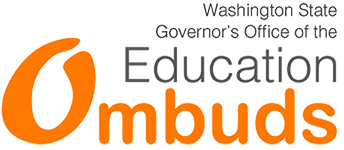Schools' Role in Prevention
Every student needs a safe space to learn and interact with their peers in a healthy and supportive way. In 2002, Washington State adopted a law, RCW 28A.300.285, prohibiting harassment, intimidation and bullying in every school. In 2007, it was amended to include electronic forms of harassment, intimidation and bullying.
SCHOOL DISTRICT MODEL POLICY & PROCEDURE (2011 changes)
Since August 1, 2011, all Washington school districts must adopt the model policy and procedure developed by the Office of the Education Ombuds, the Office of the Superintendent of Public Instruction and the Washington School Directors Association. Included is a requirement that schools communicate the policy and procedure to all parents, school staff and students to enable the entire community to work together and prevent bullying. Here are some of the highlights from the new model policy and procedure:
- Any school staff who observes, overhears, or otherwise witnesses bullying or harassment, must take immediate appropriate action and report it promptly.
- The district will implement prevention strategies including individual, classroom, school and district-level approaches.
- Students and staff will receive annual training on district's policy and procedure and preventing bullying.
- The principal or designee will acknowledge the incident that has been reported with an Incident Report Form within 2 school days to the parents of the complainant and alleged aggressor.
- An investigation for each incident will be fully conducted in 5 school days from when the Incident Report Form is filed.
- If necessary, corrective measures will be decided and implemented 12 school days from when the Incident Report Form is filed.
Bullying is not something schools and families should take lightly. Bullying is a repeated negative behavior that takes advantage of a less-powerful person, and sometimes even makes the student who is bullied feel at fault. Hitting, name calling, shunning and shaming are all forms of bullying. So are spreading rumors, gossiping and making threats online. School staff members who know the facts and work as a team to prevent and address bullying improve the school climate and prevent further incidents.
All School Adults Have a Role to Stop Bullying
Educators have the responsibility to maintain a safe environment for students to academically and socially develop. As a leader, educators and school staff can help prevent bullying by building strong relationships with students, intervening when signs of bullying are witnessed or reported, and supporting bullying prevention. The following are specific steps educators can take:
PRINCIPALS:
- School climate - Work with staff, students, school partners, and families to create social norms around inclusion and positive behaviors. Anti-bullying expectations and should be practiced by everyone in the school community. Promptly address bullying behavior.
- Implement evidence-based prevention programs designed to increase social competency, improve school climate, and eliminate harassment, intimidation, and bullying in schools.
- Ensure students annually receive age-appropriate information on how to recognize and prevent harassment, bullying, and intimidation. This can occur at student orientation sessions and other occasions.
- Form a group to coordinate the school's bullying prevention program. Include administrators, teachers from each grade, non-teaching staff members, school counselors, and parents.
- Increase supervision in areas of the school or times of the day when bullying occurs (e.g. lunch, recess, afterschool release, etc.).
- Oversee the investigation process in 5 school days or less from the time the Incident Report Form is submitted.
- Ensure the resolution of the case is documented on the student information system and written notification of outcome is given to families.
- Implement corrective measures in 12 days from when the Incident Report Form is submitted if the accused bully is found at fault.
SCHOOL DISTRICT ADMINISTRATORS & COMPLIANCE OFFICERS:
- Provide annual training on the school district's policy and procedure, including staff roles and responsibilities, how to monitor common areas, and use of the district's Incident Reporting Form.
- Oversee schools are implementing evidence-based prevention programs designed to increase social competency, improve school climate, and eliminate harassment, intimidation, and bullying in schools.
- The Compliance Officer will support school administrators and staff in resolving complaints.
TEACHERS & STAFF:
- Increase supervision in areas of the school or times of the day when bullying occurs (e.g. lunch, recess, afterschool release, etc.).
- Intervene immediately when harassment, intimidation or bullying occurs. Continue to monitor the situation with the students involved to ensure it doesn't continue.
- Document incidents in writing. If there is potential for clear and immediate physical harm to the victim, contact law enforcement and parent/guardian right away.
- When unsure if you have been confronted with possible harassment, intimidation, or bullying, consult with the principal, school counselor, and/or district compliance officer.
